Pastels – what they are and how to use them
I recently read an interesting article about a new pastel on the market. It was interesting because, whilst the company waxed lyrical about how wonderful their product is, and I don’t doubt this, it occurred to me that there was nothing to compare it to.
Granted, you are not going to bring a product to the market and state that another manufacturer’s offering is better than yours, but it would make me more inclined to consider purchasing it if I knew where it fell in terms of quality compared to existing products. I am no expert in this field, so if you know more, great, but many of my readers are looking for guidance and I hope that this helps.
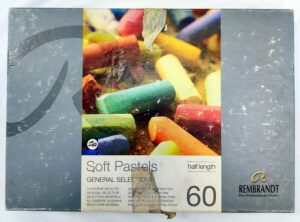
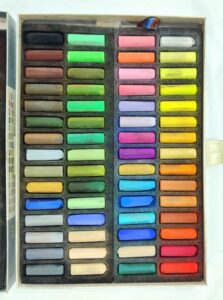
There are a number of different names used for pastels so let’s deal with that issue first. The names which cause the most confusion are soft pastels. For some inexplicable reason, soft pastels are referred to as chalk pastels, chalk crayons or simply chalks. This misuse of the correct terminology creates the idea that they are the same thing. They are not and this misunderstanding sadly feeds into the notion that pastel paintings are not “in the same league” as other artforms and this affects the value placed upon them.
If you follow me regularly you will know that I hate all that snobbery surrounding arts verses crafts. The snobbery persists within the arts world, with many people still believing that oil paintings are considered to be ‘the best’ and therefore you should pay a higher price than you would for acrylics, watercolour, coloured pencil etc. You will also find that some major art competitions will only accept paintings produced in oils or acrylics. In these so-called enlightened days, I believe we all need to embrace diversity in every part of our lives, but I promise I will not go down that political rabbit hole.
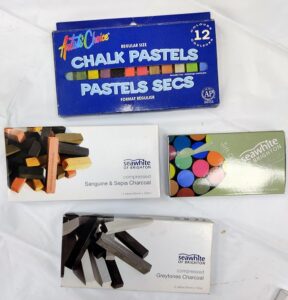
Let’s look at the facts. School chalks are made to use on blackboards and pavements (sidewalks for my US readers). The base material is calcium carbonate, which is a form of limestone. To make school chalks, the limestone is crushed and water is added to make a thick slurry similar in consistency to clay. This is cured in an oven for about four days and then cut into sticks. To make the chalks in different colours, pigments are added to the crushed limestone before the water and then it is baked in the same way.
For artists pastels the procedure is similar, but calcium sulphate is used instead. Calcium sulphate, commonly known as gypsum, is a colourless powder which is also used in making plaster for covering walls. I am not going to go into the scientific differences, as if you are really interested that is an afternoon you can spend researching for yourself, but the dry mixture is mixed with clay and oils as the binder to produce a slurry which is more like toothpaste in consistency. Adding oils rather than water means that the end product is relatively moist. The formed sticks are then generally left to air dry.
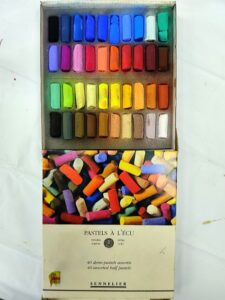
With soft pastels, the form most widely used by artists, the sticks contain a high proportion of pigment to binder, allowing for a huge range of colours with the binders allowing them to be easily smudged and blended but resulting in a high level of dust. Some artists use a fixative to keep the pastel particles in place before framing but this can dull the colours so many artists either do without or they will use fixative towards the end of their painting but leave the finishing touches unfixed.
Pan pastels are formed using a minimal amount of binder in flat compacts, similar to makeup. These pastels are applied using soft sponge tools. Hard pastels have a higher proportion of binder with less pigment. This allows for sharper imagery and they are often used for preliminary sketches. They tend to be cheaper and are only available in fewer (and less brilliant) colours.
Pastel pencils are just like a normal pencil but have pastel in place of graphite (lead). These are really good for adding fine details to your artwork.
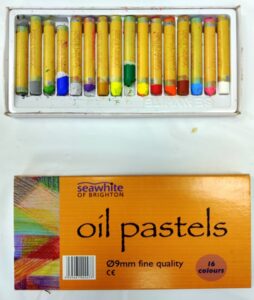
Oil pastels are made using linseed oil, just like oil paints. They have a beautiful, butter soft consistency and wonderfully intense colours. They are slightly more difficult to blend than soft pastels but, unlike them, they don’t need fixing.
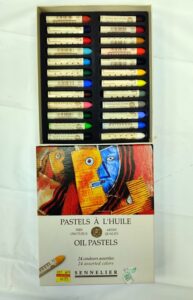
Oil pastels are dense, so they fill the grain on paper or canvas, but they can be thinned with turpentine, allowing the use of a paint brush to move them around the surface of your painting. I know many artists who use oil pastels over their acrylic paintings to give wonderful, vibrant final marks.
Water soluble pastels contain a component which allows the colour to be thinned out to make washes. They are easily blended and the depth of colour can be varied depending on the amount of water used as this type of pastel tends to be restricted to a range of strong colours.
You won’t be surprised to know, I am sure, that there has been rather a lot of debate within art societies about what constitutes a pastel. The Pastel Society in the UK places the emphasis on pastel being a ‘dry medium’ and states that “Pastels, including Oil pastel, Charcoal, Pencil, Conte, Sanguine or any other dry media” are acceptable but the debate still goes on.
Permanent works of art can be produced using pastels so long as they meet appropriate archival considerations. To meet these criteria, the pastels used must contain light fast pigments, the work must be made on archival quality surfaces which are acid free, and the support protected under glass.
These works must be properly mounted and framed so that the glass doesn’t touch the pigment; spacers are placed between the artwork and the surrounding mounting board so that pigment falls between them and isn’t visible from the front of the framed work. Framing in this way also prevents the deterioration of the work which can come about through condensation.
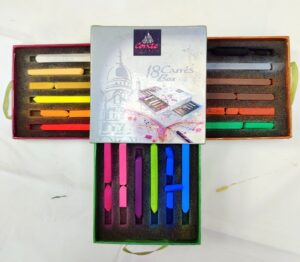
I need to add a health warning here. Pastels produce a large amount of dust which, if inhaled, can irritate the lungs and cause respiratory problems. Also, some of the pigments in pastels are toxic, for example the cadmium colours. These have been removed from most commercial products, but are still legally available to artists, who won a long battle with the EU, which wanted to ban them all on environmental grounds, a few years ago. An exemption was allowed on the basis that the quantities artists use are too small to be significant.
However, the fact remains that cadmium is a toxic heavy metal, so regardless of which type of product you use – oil, acrylics, watercolour etc. – the cadmium colours are the ones to be particularly mindful of.
It is advisable to work in ways that reduce the risk of inhaling dust. Maybe, like me, you’ll opt to wear a face mask. Given that we all had to get used to wearing masks during the Covid-19 pandemic, this shouldn’t be too onerous a task.
If you want more specific advice, the manufacturers/suppliers of your products are best placed to provide information on safe use, and if you use them professionally, they have been legally obliged to provide such data for many years.
In my experience though, when buying pastels, you get what you pay for. Cheaper brands have less pigment and tend to be harder. The expensive brands have a higher pigment quality but are very soft and crumbly.
If you have enjoyed reading this post, please like and follow me and share it with people who you think might be interested. I am always looking for new artists to feature and if there is a subject you would like me to write about, I will be happy to consider it. Sharing, liking and following my blogs increases the number of people the algorithm shows them to. Thank you in advance for supporting me this way.
